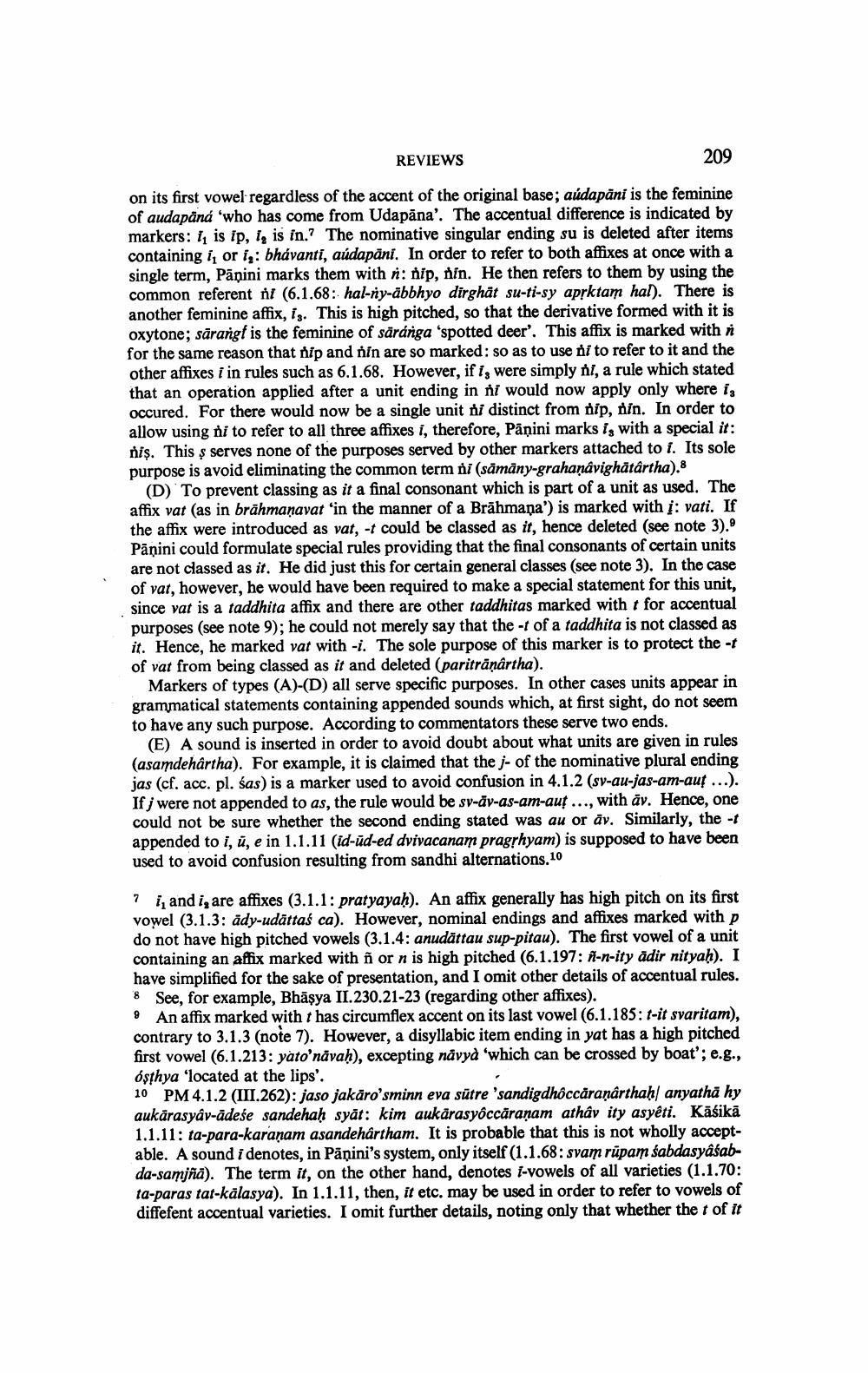Book Title: Reviews Of Different Books Author(s): Publisher: View full book textPage 3
________________ REVIEWS 209 on its first vowel regardless of the accent of the original base; audapani is the feminine of audapana 'who has come from Udapana'. The accentual difference is indicated by markers: 1, is ip, i, is in.? The nominative singular ending su is deleted after items containing i, or ig: bhavanti, audapani. In order to refer to both affixes at once with a single term, Panini marks them with n: nip, nin. He then refers to them by using the common referent ni (6.1.68: hal-ny-abbhyo dirghat su-ti-sy aprktam hal). There is another feminine affix, ig. This is high pitched, so that the derivative formed with it is oxytone; sarangt is the feminine of saranga 'spotted deer'. This affix is marked with for the same reason that nip and nin are so marked: so as to use si to refer to it and the other affixes i in rules such as 6.1.68. However, if iz were simply ni, a rule which stated that an operation applied after a unit ending in ni would now apply only where is occured. For there would now be a single unit ni distinct from nip, nin. In order to allow using ni to refer to all three affixes i, therefore, Panini marks is with a special it: nis. This s serves none of the purposes served by other markers attached to i. Its sole purpose is avoid eliminating the common term ni (samany-grahanavighatartha). (D) To prevent classing as it a final consonant which is part of a unit as used. The affix vat (as in brahmanavat 'in the manner of a Brahmana') is marked with i: vati. If the affix were introduced as vat, -t could be classed as it, hence deleted (see note 3). Panini could formulate special rules providing that the final consonants of certain units are not classed as it. He did just this for certain general classes (see note 3). In the case of vat, however, he would have been required to make a special statement for this unit, since vat is a taddhita affix and there are other taddhitas marked with t for accentual purposes (see note 9); he could not merely say that the -t of a taddhita is not classed as it. Hence, he marked vat with -i. The sole purpose of this marker is to protect the -t of vat from being classed as it and deleted (paritranartha). Markers of types (A)-(D) all serve specific purposes. In other cases units appear in grammatical statements containing appended sounds which, at first sight, do not seem to have any such purpose. According to commentators these serve two ends. (E) A sound is inserted in order to avoid doubt about what units are given in rules (asamdehartha). For example, it is claimed that the j- of the nominative plural ending jas (cf. acc. pl. sas) is a marker used to avoid confusion in 4.1.2 (sv-au-jas-am-aut ...). Ifj were not appended to as, the rule would be sv-av-as-am-aut..., with av. Hence, one could not be sure whether the second ending stated was au or ay. Similarly, the -t appended to i, u, e in 1.1.11 (id-ud-ed dvivacanam pragshyam) is supposed to have been used to avoid confusion resulting from sandhi alternations. 10 7 i and i, are affixes (3.1.1: pratyayah). An affix generally has high pitch on its first vowel (3.1.3: ady-udattas ca). However, nominal endings and affixes marked with p do not have high pitched vowels (3.1.4: anudattau sup-pitau). The first vowel of a unit containing an affix marked with n or n is high pitched (6.1.197: n-n-ity adir nityah). I have simplified for the sake of presentation, and I omit other details of accentual rules. 8 See, for example, Bhasya II.230.21-23 (regarding other affixes). 9 An affix marked with t has circumflex accent on its last vowel (6.1.185: t-it svaritam), contrary to 3.1.3 (note 7). However, a disyllabic item ending in yat has a high pitched first vowel (6.1.213: yato'navah), excepting navyd 'which can be crossed by boat'; e.g. osthya 'located at the lips'. 10 PM 4.1.2 (III.262): jaso jakaro'sminn eva sutre 'sandigdhoccaranarthah| anyatha hy aukarasyav-adese sandehah syat: kim aukarasyoccaranam athay ity asyeti. Kasika 1.1.11: ta-para-karanam asandehartham. It is probable that this is not wholly acceptable. A sound i denotes, in Panini's system, only itself (1.1.68: svam rupam sabdasyasabda-samjna). The term it, on the other hand, denotes i-vowels of all varieties (1.1.70: ta-paras tat-kalasya). In 1.1.11, then, it etc. may be used in order to refer to vowels of diffefent accentual varieties. I omit further details, noting only that whether the t of itPage Navigation
1 2 3 4 5 6 7 8 9 10 11 12 13 14 15 16 17 18 19 20 21 22 23 24 25 26 27 28 29 30 31 32 33
